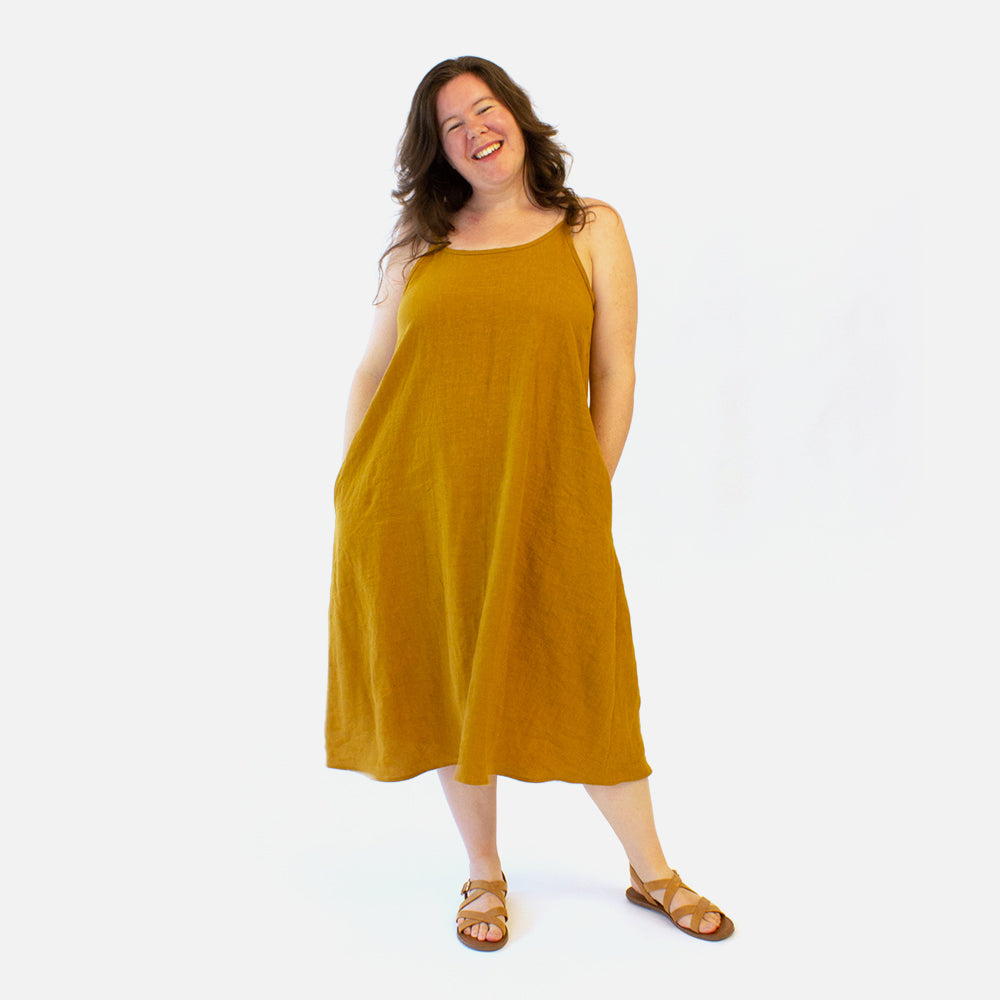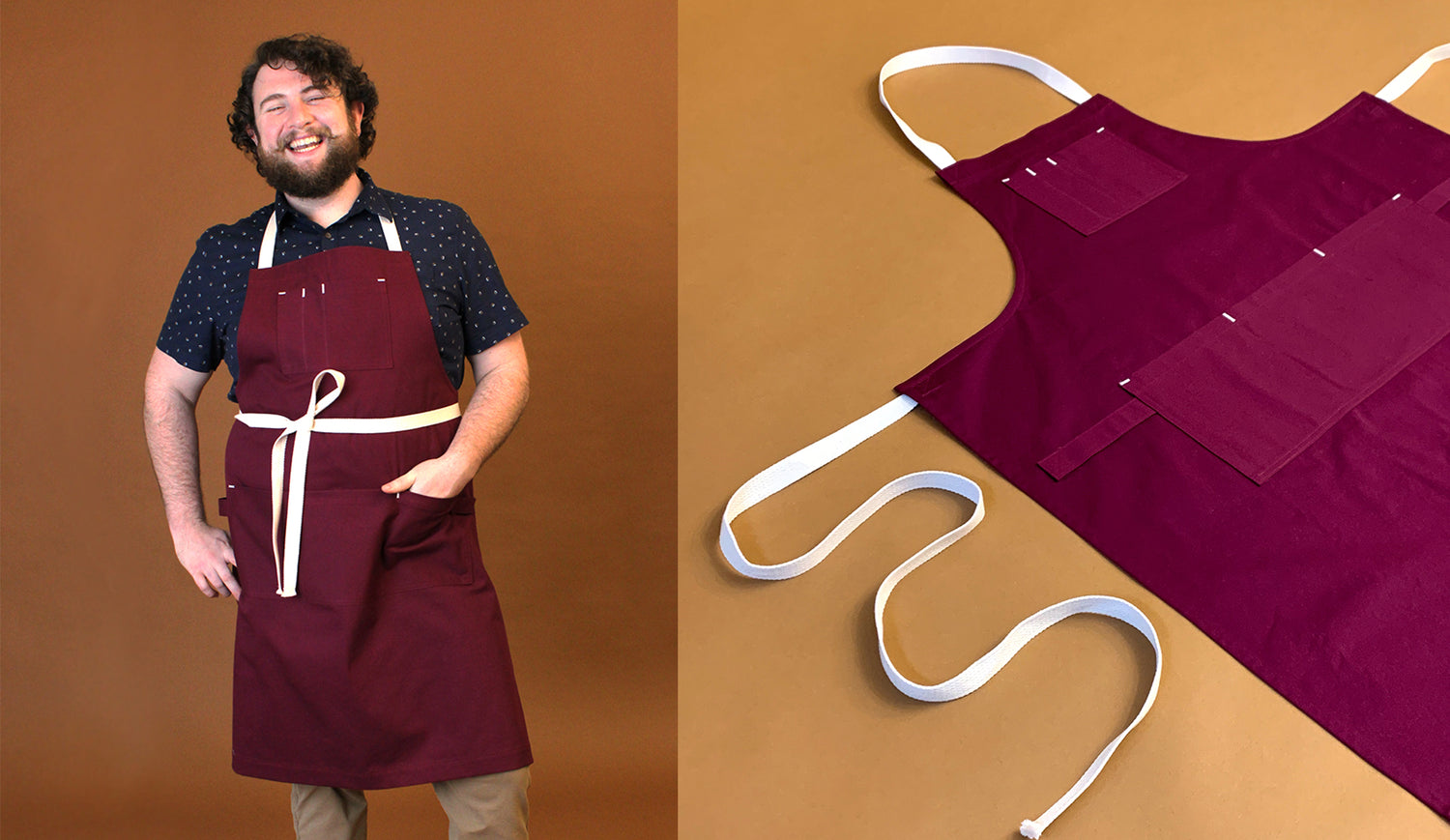The Lockhart Jumpsuit and Dress is one of our most versatile patterns ever! Not only do you get to choose between a jumpsuit and dress, you get four length options for each view, and today we are going to show you how to separate out the skirt and pants to get even more out of this design. This hack is really simple and fun and takes this pattern to a whole new level.

Pssst: Wondering if you can also separate out the top and make a fitted bandeau tank? We’ve got you covered! Check out this blog post here to see that hack.

Lockhart is on sale this week for 20% off! No code required.

Just like with the full pattern, you get to choose which length you want for your skirt or pants hack! Palazzo pants? Shorts? Midi length skirt? Short skirt? So many options and sew little time!
Fabric Requirements
We have calculated the fabric requirements and cutting layouts for this hack for you. You can view them here and print these pages out if desired!
You may also need some 1” (2.5 cm) wide elastic if you want your waistband to be a little more snug. We've added some to the samples in this blog post and you can't even see it, but it helps to ensure that as the day goes on, the waistband stays where you want it.


Lockhart Pattern Pieces Needed
For the pants, you will need the pattern pieces for the front leg (7), back leg (8), and pant pocket (9). For the skirt, you will need the front skirt (10), back skirt (11) and skirt pocket (12). Of course, you can skip the pockets if you want to. You will also need the skirt/pant zipper interfacing piece (13).

In addition to the existing pattern pieces, you will need new front and back waistband pattern pieces. You can download the pattern pieces here: 4 pages printed on A4/letter-sized paper. For sizes 0-8, you only need to print pages 1 and 2.


Alternatively, you can cut out the waistband pieces based on the measurements below. Both front and back waistbands are 3.75” (9.5 cm) tall. The amounts provided already include ⅝” (1.6 cm) seam allowances. To make a pattern piece for interfacing half of the waistband, cut the pattern pieces to half the height: 1.875” (4.7 cm) tall.
Imperial (inches)
| 0 | 2 | 4 | 6 | 8 | 10 | 12 | 14 | 16 | 18 | 20 | 22 | 24 | 26 | 28 | 30 | 32 | 34 | |
|---|---|---|---|---|---|---|---|---|---|---|---|---|---|---|---|---|---|---|
| Front Waistband | 6.8 | 7 | 7.3 | 7.6 | 7.8 | 8.1 | 8.4 | 8.9 | 9.4 | 10 | 10.5 | 11 | 11.5 | 12 | 12.5 | 13 | 13.5 | 14 |
| Back Waistband | 7.5 | 7.7 | 8 | 8.2 | 8.5 | 8.8 | 9 | 9.5 | 10 | 10.5 | 11 | 11.5 | 12 | 12.5 | 13 | 13.5 | 14 | 14.5 |
Metric (cm)
| 0 | 2 | 4 | 6 | 8 | 10 | 12 | 14 | 16 | 18 | 20 | 22 | 24 | 26 | 28 | 30 | 32 | 34 | |
|---|---|---|---|---|---|---|---|---|---|---|---|---|---|---|---|---|---|---|
| Front Waistband | 17.5 | 18 | 18.5 | 19 | 20 | 20.5 | 21.5 | 22.5 | 24 | 25 | 26.5 | 27.5 | 29 | 30 | 31.5 | 32.5 | 34 | 35 |
| Back Waistband | 19 | 19.5 | 20 | 21 | 21.5 | 22 | 23 | 24 | 25.5 | 26.5 | 28 | 29.5 | 30.5 | 31.5 | 33 | 34.5 | 35.5 | 36.5 |
Make sure to add center notches at the short ends of both front and back waistbands if you are using the above cutting charts. The front waistband is cut on the fold.

Cutting and Interfacing
Cut your pattern pieces as directed, following the cutting layouts provided on pages 3 and 4 of the fabric requirements and cutting layouts booklet. For the waistband, cut one front waistband on the fold and two back waistbands.
Cut two pieces of skirt/pant zipper interfacing, one front waistband interfacing on the fold, and two back waistband interfacing pieces. If you are working with a lightweight or slinky fabric, we highly recommend interfacing the entire waistband using light to medium-weight interfacing.
Apply the interfacing to the wrong side of half (or all) all the waistband pieces and the wrong side of the center back skirt/pants (where the zipper will go).

Instructions
Follow steps 2 and 16 in the instruction booklet. Skip Checkpoint #2 (page 28) since you are not sewing a dress or a jumpsuit. Then, proceed to steps 17-33 per your chosen view and complete checkpoint #3. Once these steps are completed, follow the steps below to finish your pants or skirt.

1. With the right sides together, attach the back waistbands to the front waistband at the short sides. Press seam allowances open.

2. Fold the long edge on the non-interfaced side of the assembled waistband ⅝” (1.6 cm) to the wrong side and press.

3. With the right sides together and matching side seams, pin the interfaced side of the waistband to the pants/skirt. Sew and press seam allowances towards the waistband.

4. Place the open zipper face down and, using low heat, press the zipper teeth out and away from the zipper tape so they lie slightly flat. This will help you sew as close to the teeth as possible when installing the zipper. Note: this step is not necessary if you plan to use an invisible zipper foot.

5. Place the invisible zipper face down on the right side of the pants/skirt so that the coil sits at the ⅝” (1.6 cm) seam line.
Line up the top zipper stop to sit about ⅛” (0.3 cm) below the back waistband's middle notch. Depending on the width of your zipper tape, its edge may line up with the edge of the pants/skirt center back. Or if your zipper tape is narrow, it may sit in from the edge. Pin the zipper securely in place.
If you are using a longer-than-required zipper, the end of your zipper will extend onto the pants/skirt past the center back zipper notch. That is okay! You will trim it later.

6. Using a zipper foot or invisible zipper foot, sew down the length of the zipper as close to the teeth as possible. Make sure your stitches do not land on the teeth. If your zipper is longer than recommended, sew to the zipper notch on the back seam and not past it.
Fold the top edge of the zipper down, angling it slightly away from the teeth. Tack it in place with a few stitches.

7. Position the other side of the zipper face down on the other side of the opening so the coil is sitting at the 5/8” (1.6 cm) seam line. The bottom of your zipper should look like the illustration in the circle.

Be sure to line up the waistband attachment seam on either side of the zipper (see page 39 of the instruction booklet for tips). Pin securely in place. Sew as close to the teeth as possible.
Follow steps 39-41 on page 39 of the instruction booklet if using a longer-than-recommended zipper. Then, proceed to the next step here.
8. If necessary, close the gap at the bottom of the zipper by stitching along the center back until you meet the zipper base. Use a regular zipper foot here and place the needle in the far side position to be as close to the zipper/stitching line as possible.

Try the pants/skirt on to see how the waistband fits. In testing, we found that the waistband behaved differently in different fabrics. If your waistband feels a little loose, do not fret; we will show you how to insert some elastic into your waistband.
9. With the right sides together, fold the waistband onto itself over the top of the zipper. Keep the pre-pressed edge of the waistband folded here and line it up to cover the waistband attachment seam.
10. Sew from the top of the waistband down to its folded edge, stitching as close to the zipper teeth as possible. Use a regular zipper foot in this step and place the needle in the side position to stitch next to the zipper teeth. Do not stitch too close, or the zipper teeth will get caught in the seamline.


If your waistband is perfect and does not need to be tighter, skip to step 14 in this post.
11. Wrap a piece of 1” (2.5 cm) wide elastic around your waist until it is taught but not too tight. Cut it without adding any seam allowances.

12. With the waistband still inside out, pin each elastic end onto the waistband seam allowances. The elastic will point away from the waistband and lie between the zipper. Make sure the elastic is not twisted. Attach the elastic to the seam allowances using a zig-zag or a few rows of straight stitches.

13. Clip the top corners of the waistband and turn it right side out. Bring the pre-folded edge of the waistband over the waist attachment seam so that it overlaps it by ⅛” (0.3 cm). Working from the right side, pin it in place, placing the pins in the ditch of the waist attachment seam.

If you have inserted elastic, complete this and the step below in two sections. First, work on the sides of the back waistband, stretching the elastic so the back waistbands lie flat. Stitch the back waistbands down, hiding the beginning of your stitches in the side seam. Once you have stitched the back waistband down, stretch the elastic so that the front waistband is flat and repeat steps 13 and 14 to secure the front waistband in place.
14. Working from the right side of the pants/skirt, stitch-in-the-ditch of the waist seam, catching the folded edge of the waistband on the wrong side. Go slowly and check to ensure you catch the waistband edge as you sew.

Complete step 47 of the instruction booklet to hem the pants/skirt, and you are done!

We hope you enjoy the Lockhart pants and skirt hack! I absolutely love both of these as separate pieces and I have been wearing them a lot. We made my pinstripe pants from viscose linen noil so they are so swishy and fun. The skirt is made in a mid-weight linen and it feels amazing to wear.




I’ve paired both of these hacks with our Lockhart top hack which you can find instructions for here. I love the idea of making this pattern as separates in the same fabric so you can have a matching set but still wear them as individual pieces too.

Lockhart is on sale this week for 20% off! No code required.






